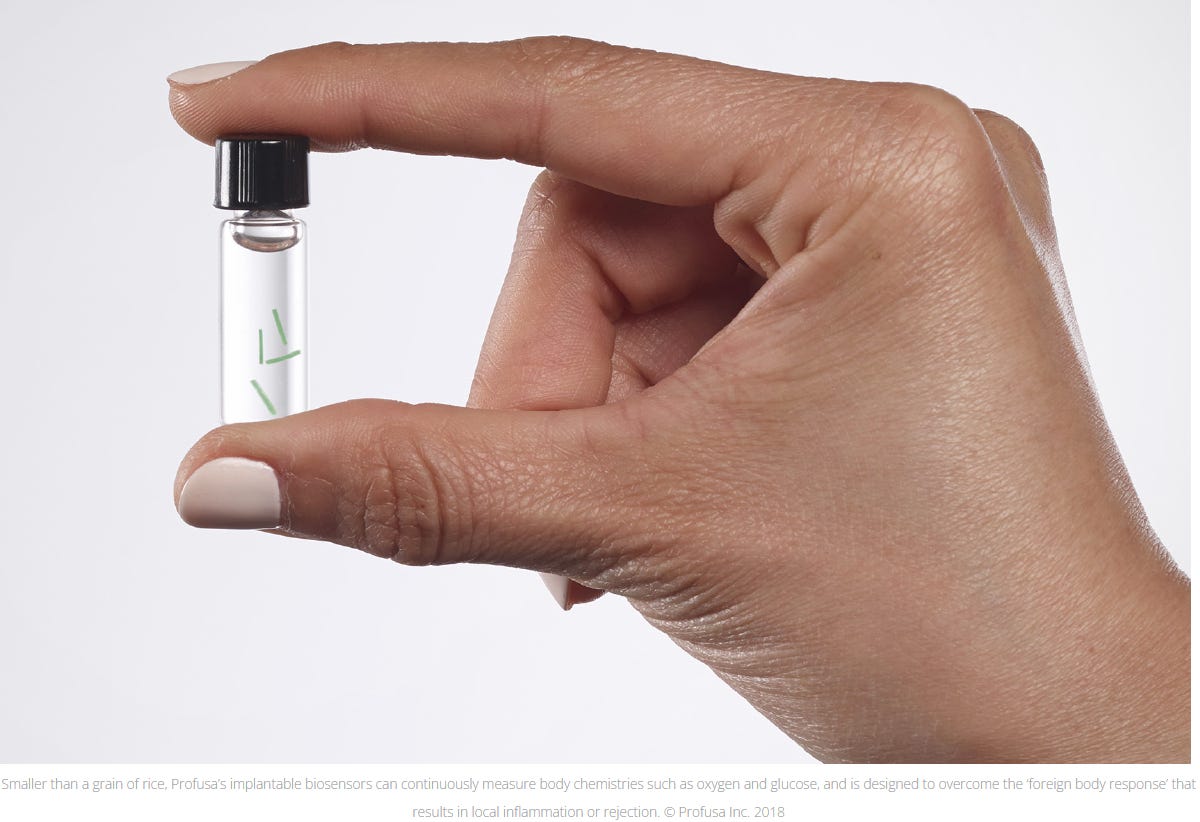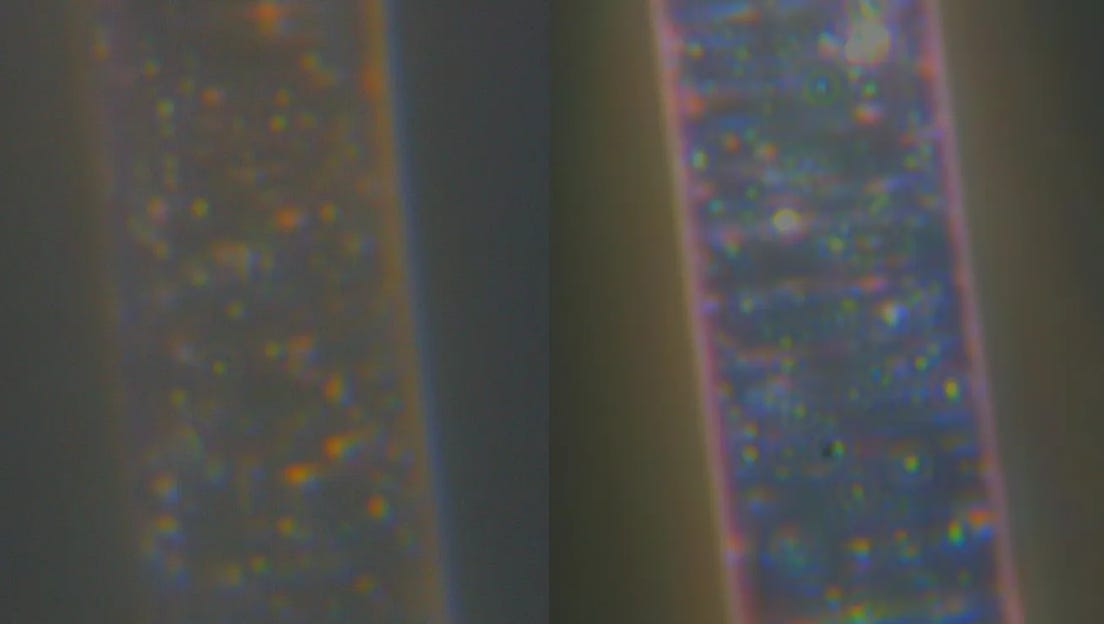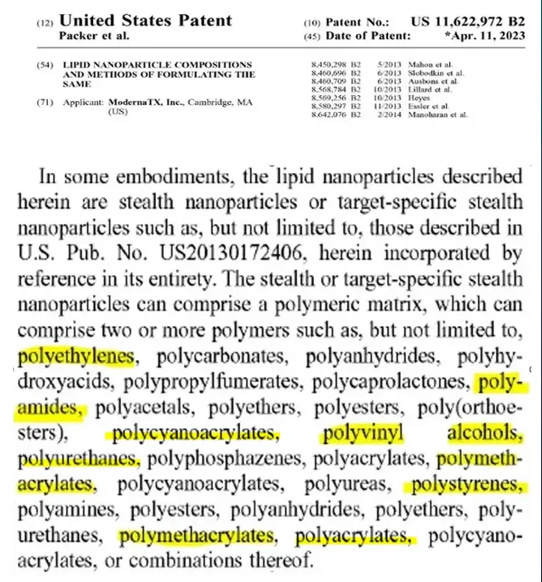Are The Hydrogel Filaments That Come Out of COVID19 Vaccinated and Unvaccinated Now Similar To DARPA Military-Funded Wireless Fluorescent Implantable Biosensors?
A Military-Funded Biosensor Could Be the Future of Pandemic Detection
In 2020, an article was published discussing a hydrogel based wireless chemical hydrogel biosensor with fluorescent light emission developed by Profusa. This is interesting, as the filaments coming out of people’s skin, COVID19 vaccinated and unvaccinated appear to have similar fluorescent hydrogel characteristics.
I have shown the filaments that come out of COVID19 vaccinated individuals skin, which behave like Morgellon’s filaments, as well as the corresponding facial tattoo that can be seen under UV light.
Image: Filament coming out of COVID19 vaccinated individuals - attracted to human skin. courtesy of Dr Coy
Then I showed that COVID19 unvaccinated people affected by shedding had similar fluorescent filaments come out of their skin:
Image: COVID19 unvaccinated individual has blue fluorescent filaments coming out of their skin. AM Medical
The filaments themselves look like technological devices under the microscope:
Image: Darkfield microscopy of filament coming out of the skin of COVID19 unvaccinated individual. AM Medical
This is interesting in light of this hydrogel long biosensor developed by Profusa, which develops injectable biosensors:
Why are pandemics so hard to stop? Often it’s because the disease moves faster than people can be tested for it. The Defense Department is helping to fund a new study to determine whether an under-the-skin biosensor can help trackers keep up — by detecting flu-like infections even before their symptoms begin to show. Its maker, Profusa, says the sensor is on track to try for FDA approval by early next year.
The sensor has two parts. One is a 3mm string of hydrogel, a material whose network of polymer chains is used in some contact lenses and other implants. Inserted under the skin with a syringe, the string includes a specially engineered molecule that sends a fluorescent signal outside of the body when the body begins to fight an infection. The other part is an electronic component attached to the skin. It sends light through the skin, detects the fluorescent signal and generates another signal that the wearer can send to a doctor, website, etc. It’s like a blood lab on the skin that can pick up the body’s response to illness before the presence of other symptoms, like coughing.
The announcement comes as the United States grapples with COVID-19, a respiratory illness that can present in flu-like symptoms such as coughing and shortness of breath. The military is taking a leading role in vaccine research, Joint Chiefs of Staff Chairman Gen. Mark Milley told reporters at the Pentagon on Monday. “Our military research labs are working feverishly around the horn here to try to come up with a vaccine. So we’ll see how that develops over the next couple of months,” Milley said. U.S. troops themselves are also at risk. A U.S. soldier in South Korea became the first U.S. service member to contract the virus, the Wall Street Journal reported in February.
Profusa’s newest funded study, which the company announced on Tuesday, will test how well the sensor can detect influenza outbreaks up to three weeks before it’s possible to detect them using current methods. Because the gel doesn’t actually emit any signal, it wouldn’t give away a soldier’s position, so the sensor could be used in sensitive settings like behind enemy lines, Profusa CEO Ben Hwang said.
Hwang said his company has received grants from the Defense Advanced Research Projects Agency, or DARPA, since around 2011. “They gave us grant money to help our research and as we prove out a certain milestone, as we de-risk the technology, they give us a second phrase and a third phase and provide support,” he said. “Their support has transitioned from grants into these types of programs that create real-world evidence.”
Hwang said DARPA is helping the company reach out to other outfits within the Defense Department that might use the device on troops or service members. That could include partnerships with U.S. Special Operations Command, for instance, or, Indo-Pacific Command. He declined to comment on conversations with specific military customers.
This article on Profusa’s website from 2018 discussing they have overcome the bodies rejection of the synthetic materials:
Injectable Body Sensors Take Personal Chemistry to a Cell Phone Closer to Reality
NEW ORLEANS, March 19, 2018 — Up until now, local inflammation and scar tissue from the so-called “foreign body response” has prevented the development of in-body sensors capable of continuous, long-term monitoring of body chemistry. But today scientists are presenting results showing tiny biosensors that become one with the body have overcome this barrier, and stream data to a mobile phone and to the cloud for personal and medical use.
“While fitness trackers and other wearables provide insights into our heart rate, respiration and other physical measures, they don’t provide information on the most important aspect of our health: our body’s chemistry,” explained Natalie Wisniewski, Ph.D. “Based on our ongoing studies, tissue-integrated sensor technology has the potential to enable wearables to live up to the promise of personalized medicine, revolutionizing the management of health in wellness and disease.” Dr. Wisniewski, who leads the team of biosensor developers, is the chief technology officer and co-founder of Profusa Inc., a San Francisco Bay Area-based life science company.
The researchers are presenting their results today at the 255th National Meeting & Exposition of the American Chemical Society (ACS). ACS, the world’s largest scientific society, is holding the meeting here through Thursday. It features more than 13,000 presentations on a wide range of science topics.
Overcoming the Foreign Body Response
Conventional sensors, such as those found in continuous glucose monitors, have a sensing electrode wire that penetrates the skin to measure a target chemical in the fluid that surrounds cells. But because the body “sees” the electrode as foreign material, it needs to be removed and replaced within several days at a different location to avoid the effects of inflammation and scar tissue that eventually prevents the electrode from functioning accurately.
The team at Profusa is developing a family of tiny biosensors composed of a tissue-like hydrogel, similar to a soft contact lens, that are painlessly placed under the skin with a single injection. Rather than being isolated from the body, the biosensors work fully integrated within the body’s tissue — without any metal device or electronics, thereby overcoming the body’s attempts to reject it. To date, the injected biosensors have functioned for as long as four years.
Smaller than a grain of rice, each biosensor is a flexible fiber about 5 mm long and half a millimeter wide, comprised of a porous scaffold that induces capillary and cellular ingrowth from surrounding tissue. The hydrogel is linked to light-emitting fluorescent molecules that continuously signal in proportion to the concentration of a body chemical, such as oxygen, glucose, or other biomolecule of interest.
Clearly a fluorescent signal is sent to the skin according to the company.
Adhered to the skin’s surface or held by hand, a separate optical reader is used to read the fluorescent signal from the embedded biosensor. The reader sends excitation signals through the skin to the biosensor, which then emits fluorescent light in response to the biomolecule present. The data is relayed to a smart phone for an encrypted personal record and historical tracking. Data can be shared securely via digital networks with healthcare providers.
Dr Coy has shown his research on the fluorescent glow of people who received the COVID19 injection.
In my clinic I use a 365 nm UV flashlight to look at people’s face. When I first presented this research, the debunkers came out of the woodwork claiming that I am just looking at fluorescent bacteria. But I analyzed the orange glowing spots under my Darkfield microscope and showed that these are polymer based mesogens just like Dr. Staninger found in Targeted Individuals.
They also contain classic polymer filaments and different dyes that are used for biosensing applications.
Dr Staninger analyzed such a biosensor mesogen and found polyamide, Graphite and Silicon amongst other chemicals. Polyamides, along with polyvinyl alcohol and polyethylene was found by Clifford Carnicom and myself in the rubbery clot specimens as well as COVID19 vaccinated and unvaccinated blood.
Image: Mesogen microchip from a Targeted Individual. courtesy Dr. Staninger
We know from the Moderna Lipid Nanoparticle patent that stealth nanoparticles of polymers, polyvinyl and many other toxic hydrogel plastics are used - all building blocks of biosensor self assembly nanotechnology.
The Argentinian researchers Dr Marcela Sangorrin and Biotechnologist Lorena Diblasi proved that the COVID19 injections contained up to 54 undisclosed elements, including paramagnetic and fluorescent Lanthanides. They also used fluorescent microscopy showing that the polymer filaments and particles that assemble glow.
I also found fluorescent mesogens that self assembled after leaving the Pfizer BioNTech solution for 5 weeks on a slide at room temperature:
Profusa has been funded by the military since 2011 and in 2018 presented at the DARPA symposium about their wireless injectable sensing system:
Profusa to Present at DARPA D60 Symposium
Profusa Software and Systems Lead, Kevin Zhao, has been selected to participate in the Defense Advanced Research Projects Agency’s (DARPA) 60th Anniversary Symposium (D60) as a DARPA Riser. The D60 Symposium takes place from September 5-7 at the Gaylord National Resort and Convention Center, National Harbor, Maryland.
DARPA hand-selected 50 early-career scientists and engineers identified as possible future industry leaders with expertise that could be important to national security. As one of the hand-selected DARPA Risers, Zhao has the distinguished honor of presenting a poster presentation to a panel of DARPA Program Managers on the current and future military applications of Profusa’s wireless sensing system. These applications include medical-grade remote monitoring of vital signs, pilot hypoxia and real-time point-of-care treatments.
DARPA has been funding this research to monitor soldiers “health” ( from the inside of the body, also called intra body area network).
In 2016, DARPA and the U.S. Army Research Office (ARO) awarded Profusa a $7.5 million dollar grant to develop the company’s implantable biosensors for the simultaneous, continuous monitoring of multiple body sensors. Over the past few years, Profusa has focused research and product development on providing real-time monitoring of a combat soldier’s health status to improve mission efficiency and overall performance. Profusa is proud to partner with DARPA to create breakthrough technologies and capabilities for our national security.
We know that DARPA also funded Moderna in the development of mRNA technology.
CAMBRIDGE, Mass., Oct. 2, 2013 /PRNewswire/ -- Moderna Therapeutics, the company pioneering messenger RNA therapeutics™, a revolutionary new treatment modality to enable the in vivo production of therapeutic proteins, announced today that the Defense Advanced Research Projects Agency (DARPA) has awarded the company up to $25 million to research and develop its messenger RNA therapeutics™ platform as a rapid and reliable way to make antibody-producing drugs to protect against a wide range of known and unknown emerging infectious diseases and engineered biological threats.
Is there any correlation between the hydrogel fluorescent biosensors funded by DARPA and the COVID19 bioweapon fluorescent self assembling mesogen and polymer filaments? We know that the stealth nanoparticles in the Moderna patents have all the polymer hydrogels that can be used for biosensing technology.
Is it just a coincidence that these biosensors work via fluorescent signaling and that is what we now see coming out of the skin and face in many of the COVID19 injected and less so, but still present in the unvaccinated? And that DARPA funded these wireless implantable biosensor technologies just as they funded the Moderna mRNA bioweapon platform?
I think that is a worthy question to ask.

















YES! for those who know it, they know it since 10 years, at least, first darpa patent of optogenetics and covid-19... bio weapon and autonomous self control of bodies via sensors an neural network
ASK SABRINA WALLACE SH'ES A SPECIALIST OF THAT
Fitness trackers also destroy melatonin and spike blood sugar - variables they only track, and don't help improve: https://romanshapoval.substack.com/p/why-tracking-our-fitness-isnt-healthy